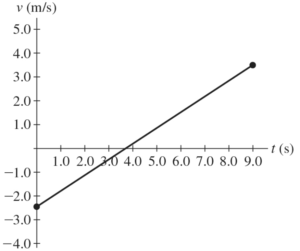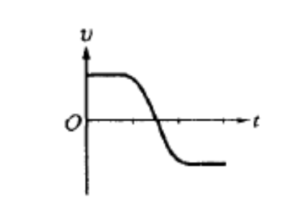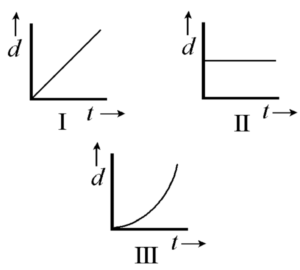0 attempts
0% avg
UBQ Credits
| Step | Derivation/Formula | Reasoning |
|---|---|---|
| 1 | \(v_f = v_i + at \) | Use the first equation of motion to relate the initial velocity, final velocity, and time. |
| 2 | \(0 \, \text{m/s} = 5.0 \, \text{m/s} – 9.8 \, \text{m/s}^2 \cdot t \) | At maximum height, the final velocity \(v_f\) is zero, the initial velocity \(v_i\) is \(5.0 \, \text{m/s}\), and the acceleration \(a\) is \(-9.8 \, \text{m/s}^2\) (due to gravity). |
| 3 | \( t = \frac{5.0 \, \text{m/s}}{9.8 \, \text{m/s}^2} \approx 0.51 \, \text{s} \) | Calculate the time interval for the rock to reach its maximum height. This is only the time to reach the maximum height, so the total time to fall back to the original location is double this time. |
| 4 | \( t_{\text{total}} = 2 \cdot 0.51 \, \text{s} \approx 1.02 \, \text{s} \) | Multiply by 2 to get the total time interval for the rock to return to its original location. |
| 5 | \(\boxed{1.02 \, \text{s}}\) | Final answer for part (a) |
| Step | Derivation/Formula | Reasoning |
|---|---|---|
| 1 | \(v_f = v_i + at \) | Use the first equation of motion to relate the initial velocity, final velocity, and time. |
| 2 | \(v_f = 5.0 \, \text{m/s} – 9.8 \, \text{m/s}^2 \cdot 1.02 \, \text{s} \) | The initial velocity \(v_i\) is \(5.0 \, \text{m/s}\), the acceleration \(a\) is \(-9.8 \, \text{m/s}^2\) (due to gravity), and the total time \(t\) is \(1.02 \, \text{s}\). |
| 3 | \(v_f \approx 5.0 \, \text{m/s} – 10.0 \, \text{m/s} = -5.0 \, \text{m/s} \) | Calculate the final velocity when the rock returns to the same height. Note the negative sign indicates the direction is downward. |
| 4 | \(\boxed{-5.0 \, \text{m/s}}\) | Final answer for part (b). |
| Step | Derivation/Formula | Reasoning |
|---|---|---|
| 1 | \(a = -g\) | Acceleration due to gravity is always acting downward. |
| 2 | \(a = -9.8 \, \text{m/s}^2\) | Even at maximum height, the acceleration due to gravity remains \(-9.8 \, \text{m/s}^2\). |
| 3 | \(\boxed{-9.8 \, \text{m/s}^2}\) | Final answer for part (c). |
| Step | Derivation/Formula | Reasoning |
|---|---|---|
| 1 | \(v_f = 0 \, \text{m/s}\) | At maximum height, the velocity of the rock is zero as it changes direction. |
| 2 | \(\boxed{0 \, \text{m/s}}\) | Final answer for part (d) |
| Step | Derivation/Formula | Reasoning |
|---|---|---|
| 1 | \(v_f^2 = v_i^2 + 2a\Delta x\) | Use the third equation of motion to relate initial velocity, final velocity, acceleration, and displacement. |
| 2 | \(0 = (5.0 \, \text{m/s})^2 + 2(-9.8 \, \text{m/s}^2)\Delta x\) | At maximum height, the final velocity \(v_f\) is zero. The initial velocity \(v_i\) is \(5.0 \, \text{m/s}\), and acceleration \(a\) is \(-9.8 \, \text{m/s}^2\). |
| 3 | \(0 = 25 – 19.6 \Delta x \) | Simplify the equation. |
| 4 | \( 19.6 \Delta x = 25 \) | Rearrange the equation to solve for height \( \Delta x \). |
| 5 | \( \Delta x = \frac{25}{19.6} \approx 1.28 \, \text{m} \) | Calculate the maximum height using the final value obtained from the rearranged equation. |
| 6 | \( \boxed{1.28 \, \text{m}} \) | Final answer for part (e). |
Just ask: "Help me solve this problem."
A car increases its forward velocity uniformly from \(40 ~ \text{m/s}\) to \(80 ~ \text{m/s}\) while traveling a distance of \(200 ~ \text{m}\). What is its acceleration during this time?
At time \( t = 0 \), a cart is at \( x = 10 \, \text{m} \) and has a velocity of \( 3 \, \text{m/s} \) in the \( -x \) direction. The cart has a constant acceleration in the \( +x \) direction with magnitude \( 3 \, \text{m/s}^2 < a < 6 \, \text{m/s}^2 \). Which of the following gives the possible range of the position of the cart at \( t = 1 \, \text{s} \)?

The motion of a particle is described in the velocity vs. time graph shown above. Over the nine-second interval shown, we can say that the speed of the particle…

The graph above shows velocity \( v \) versus time \( t \) for an object in linear motion. Which of the following is a possible graph of position (\( x \)) versus time (\( t \)) for this object?


In which of the following is the rate of change of the particle’s momentum zero?
A) \( 1.02 \, \text{s} \)
B) \( -5 \, \text{m/s} \)
C) \( -9.8 \, \text{m/s}^2 \)
D) \( 0 \, \text{m/s} \)
E) \( 1.28 \, \text{m} \)
By continuing you (1) agree to our Terms of Use and Terms of Sale and (2) consent to sharing your IP and browser information used by this site’s security protocols as outlined in our Privacy Policy.
| Kinematics | Forces |
|---|---|
| \(\Delta x = v_i t + \frac{1}{2} at^2\) | \(F = ma\) |
| \(v = v_i + at\) | \(F_g = \frac{G m_1 m_2}{r^2}\) |
| \(v^2 = v_i^2 + 2a \Delta x\) | \(f = \mu N\) |
| \(\Delta x = \frac{v_i + v}{2} t\) | \(F_s =-kx\) |
| \(v^2 = v_f^2 \,-\, 2a \Delta x\) |
| Circular Motion | Energy |
|---|---|
| \(F_c = \frac{mv^2}{r}\) | \(KE = \frac{1}{2} mv^2\) |
| \(a_c = \frac{v^2}{r}\) | \(PE = mgh\) |
| \(T = 2\pi \sqrt{\frac{r}{g}}\) | \(KE_i + PE_i = KE_f + PE_f\) |
| \(W = Fd \cos\theta\) |
| Momentum | Torque and Rotations |
|---|---|
| \(p = mv\) | \(\tau = r \cdot F \cdot \sin(\theta)\) |
| \(J = \Delta p\) | \(I = \sum mr^2\) |
| \(p_i = p_f\) | \(L = I \cdot \omega\) |
| Simple Harmonic Motion | Fluids |
|---|---|
| \(F = -kx\) | \(P = \frac{F}{A}\) |
| \(T = 2\pi \sqrt{\frac{l}{g}}\) | \(P_{\text{total}} = P_{\text{atm}} + \rho gh\) |
| \(T = 2\pi \sqrt{\frac{m}{k}}\) | \(Q = Av\) |
| \(x(t) = A \cos(\omega t + \phi)\) | \(F_b = \rho V g\) |
| \(a = -\omega^2 x\) | \(A_1v_1 = A_2v_2\) |
| Constant | Description |
|---|---|
| [katex]g[/katex] | Acceleration due to gravity, typically [katex]9.8 , \text{m/s}^2[/katex] on Earth’s surface |
| [katex]G[/katex] | Universal Gravitational Constant, [katex]6.674 \times 10^{-11} , \text{N} \cdot \text{m}^2/\text{kg}^2[/katex] |
| [katex]\mu_k[/katex] and [katex]\mu_s[/katex] | Coefficients of kinetic ([katex]\mu_k[/katex]) and static ([katex]\mu_s[/katex]) friction, dimensionless. Static friction ([katex]\mu_s[/katex]) is usually greater than kinetic friction ([katex]\mu_k[/katex]) as it resists the start of motion. |
| [katex]k[/katex] | Spring constant, in [katex]\text{N/m}[/katex] |
| [katex] M_E = 5.972 \times 10^{24} , \text{kg} [/katex] | Mass of the Earth |
| [katex] M_M = 7.348 \times 10^{22} , \text{kg} [/katex] | Mass of the Moon |
| [katex] M_M = 1.989 \times 10^{30} , \text{kg} [/katex] | Mass of the Sun |
| Variable | SI Unit |
|---|---|
| [katex]s[/katex] (Displacement) | [katex]\text{meters (m)}[/katex] |
| [katex]v[/katex] (Velocity) | [katex]\text{meters per second (m/s)}[/katex] |
| [katex]a[/katex] (Acceleration) | [katex]\text{meters per second squared (m/s}^2\text{)}[/katex] |
| [katex]t[/katex] (Time) | [katex]\text{seconds (s)}[/katex] |
| [katex]m[/katex] (Mass) | [katex]\text{kilograms (kg)}[/katex] |
| Variable | Derived SI Unit |
|---|---|
| [katex]F[/katex] (Force) | [katex]\text{newtons (N)}[/katex] |
| [katex]E[/katex], [katex]PE[/katex], [katex]KE[/katex] (Energy, Potential Energy, Kinetic Energy) | [katex]\text{joules (J)}[/katex] |
| [katex]P[/katex] (Power) | [katex]\text{watts (W)}[/katex] |
| [katex]p[/katex] (Momentum) | [katex]\text{kilogram meters per second (kgm/s)}[/katex] |
| [katex]\omega[/katex] (Angular Velocity) | [katex]\text{radians per second (rad/s)}[/katex] |
| [katex]\tau[/katex] (Torque) | [katex]\text{newton meters (Nm)}[/katex] |
| [katex]I[/katex] (Moment of Inertia) | [katex]\text{kilogram meter squared (kgm}^2\text{)}[/katex] |
| [katex]f[/katex] (Frequency) | [katex]\text{hertz (Hz)}[/katex] |
General Metric Conversion Chart
Example of using unit analysis: Convert 5 kilometers to millimeters.
Start with the given measurement: [katex]\text{5 km}[/katex]
Use the conversion factors for kilometers to meters and meters to millimeters: [katex]\text{5 km} \times \frac{10^3 \, \text{m}}{1 \, \text{km}} \times \frac{10^3 \, \text{mm}}{1 \, \text{m}}[/katex]
Perform the multiplication: [katex]\text{5 km} \times \frac{10^3 \, \text{m}}{1 \, \text{km}} \times \frac{10^3 \, \text{mm}}{1 \, \text{m}} = 5 \times 10^3 \times 10^3 \, \text{mm}[/katex]
Simplify to get the final answer: [katex]\boxed{5 \times 10^6 \, \text{mm}}[/katex]
Prefix | Symbol | Power of Ten | Equivalent |
|---|---|---|---|
Pico- | p | [katex]10^{-12}[/katex] | 0.000000000001 |
Nano- | n | [katex]10^{-9}[/katex] | 0.000000001 |
Micro- | µ | [katex]10^{-6}[/katex] | 0.000001 |
Milli- | m | [katex]10^{-3}[/katex] | 0.001 |
Centi- | c | [katex]10^{-2}[/katex] | 0.01 |
Deci- | d | [katex]10^{-1}[/katex] | 0.1 |
(Base unit) | – | [katex]10^{0}[/katex] | 1 |
Deca- or Deka- | da | [katex]10^{1}[/katex] | 10 |
Hecto- | h | [katex]10^{2}[/katex] | 100 |
Kilo- | k | [katex]10^{3}[/katex] | 1,000 |
Mega- | M | [katex]10^{6}[/katex] | 1,000,000 |
Giga- | G | [katex]10^{9}[/katex] | 1,000,000,000 |
Tera- | T | [katex]10^{12}[/katex] | 1,000,000,000,000 |
The most advanced version of Phy. 50% off, for early supporters. Prices increase soon.
per month
Billed Monthly. Cancel Anytime.
Trial –> Phy Pro
We crafted THE Ultimate A.P Physics 1 course so you can learn faster and score higher.
Try our free calculator to see what you need to get a 5 on the upcoming AP Physics 1 exam.
A quick explanation
Credits are used to grade your FRQs and GQs. Pro users get unlimited credits.
Submitting counts as 1 attempt.
Viewing answers or explanations count as a failed attempts.
Phy gives partial credit if needed
MCQs and GQs are are 1 point each. FRQs will state points for each part.
Phy customizes problem explanations based on what you struggle with. Just hit the explanation button to see.
Understand you mistakes quicker.

Phy automatically provides feedback so you can improve your responses.
10 Free Credits To Get You Started

By continuing you agree to nerd-notes.com Terms of Service, Privacy Policy, and our usage of user data.
NEW! PHY AI accurately solves all questions
🔥 Get up to 30% off Elite Physics Tutoring
🧠 NEW! Learn Physics From Scratch Self Paced Course
🎯 Need exam style practice questions?